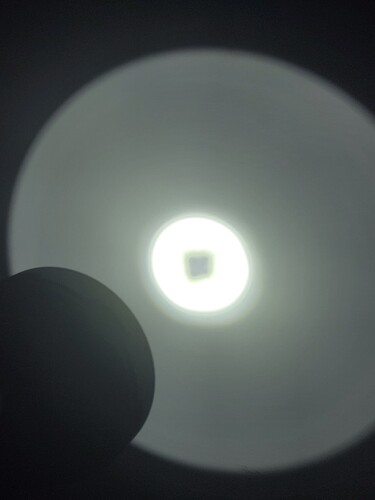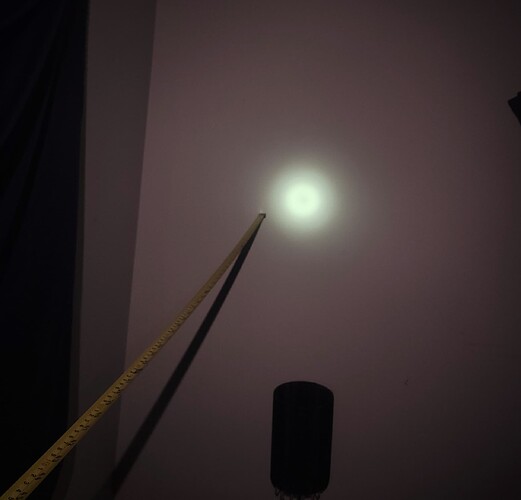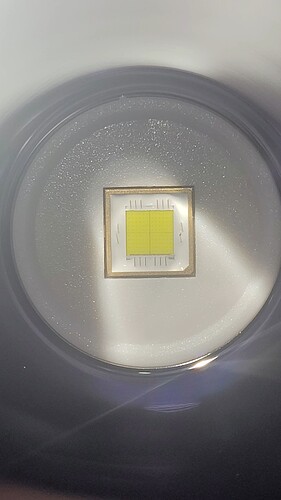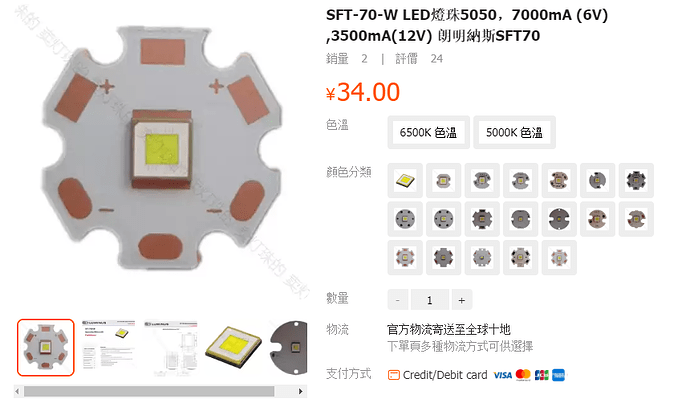2023-08-07
The SFT-70-X is now a well-known cold white LED without a dome in the 6 V class and is currently frequently installed in flashlights with a long range and high luminous flux at the same time.
This emitter was purchased from Mouser in early 2023. A date code is not known here.
Tj 85 °C, If 1,500 mA
- Type: multi-die (6 V class)
- Bin: KB, min. 1120 lm
- Color group: 652 (6500 K)
- CRI: typ. 70
- Rated voltage: min. 5.25 V - typ. 5.75 V - max. 6.25 V V
- Max. Forward current: 7,000 mA
- Max. Peak current: — mA
- Viewing angle: 120 °
- Thermal resistance: 0.6 K/W
- Max. Temperature Tj: max. 150°C
Datasheet can be downloaded here: Datasheet (newest version, Luminus)
The SFT-70-X is an LED without silicone dome (called domeless). The 4 luminous surfaces are well recognizable. The bonding wires protruding from the white silicone, which presumably serve to connect the individual luminous surfaces, are also visible.
The gold colored frame serves as a border for the white silicone and gives this LED a relatively unique look. The dark gray substrate is similar to most other LEDs.



Thanks to the XM footprint and symmetrical housing, commercially available accessories can be used freely.

The footprint is designed a bit differently than usual for most LEDs. Although it corresponds to the XM footprint (5.00 x 5.00 mm or also called “5050”), so that conventional XM (DTP) boards can be used without any problems, the individual contact surfaces protrude clearly visible from the gray substrate, which also applies to the thermal pad. This makes for a supposedly “bad” soldering with “gaps”, although the LED is firmly seated on the LED board (see also the side view of the LED).
When using commercially available LED boards like Noctigon XM20, the SFT-70-X is in general operated in the 6 V configuration (2S-2P). It is also possible to operate the LED in a 12 V configuration (4S), but this requires a special LED board with a modified connection layout.
The luminous surface consists of four individual LED chips. These are similar to the older XHP35 HI, they are arranged as closely as possible to prevent any dark stripes or gaps. This is necessary for homogeneous light pattern and avoids artifacts when using reflectors.

The luminous area is 6.51 mm² in size.
Due to the number of bonding wires, a too large increase of the Vf with increasing operating current is not to be expected (as seen as with other emitters with bonded LED chips). Nevertheless, the Vf could be somewhat higher than would be the case for an LED with more modern flip-chip design (connection from the bottom of the LED chip directly on the substrate).

Within official parameters, as far as known:
- at 7,000 mA (official maximum current): 3605 lm @ 7.10 V
- Power at official maximum: 49.7 W
- Efficiency at 7,000 mA: 74.2 lm/W
Luminus sets the official maximum current relatively high at 7 A. The data suggests that this is a 50 W LED. My sample has a slightly higher Vf than typical, although this is within the range of what the data sheet states.
Overcurrent:
- Maximum reached at 9,600 A, at this point 3926 lm @ 7.58 V
- Power at maximum 72.8 W
- Sweet spot at about 7,000 A (3605 lm @ 7.10 V)
- Power at sweet spot 49.7 W
- Efficiency at maximum 54.0 lm/W
- Efficiency in the sweet spot 74.2 lm/W
Overcurrenting is not recommended. The power, which increases by more than 30% compared to the official maximum specifications, does not justify the luminous flux, which is only about 10% higher. If necessary, it may even be advisable to reduce the operating current to 5.5 to 6 A in order to significantly increase efficiency.
Values at 25 °C Tsp, at 85 °C Tsp values are 13 % lower

The luminance is high, but the maximum current is required for this. At the official maximum current, the luminance is about on a level of the XHP35 HI or the old XP-L HI V3, but with significantly higher luminous flux. This is the feature, which is why this LED is currently mainly installed in lamps with high range.

The light pattern is good. There are no disturbing artifacts like donut holes, and the spot is sharply defined. There are also no disturbing color fringes or other anomalies. For these reasons, the SFT-70-X is suitable for flashlights without any problems.
When using a zoom lens, the structure of the four illuminated areas becomes visible, but this does not bother much thanks to the almost non-existent gaps between the LED chips.

Thanks to the narrower color grouping (652), which excludes the reddest or greenest tints, the light color is okay, at least at higher operating currents. As the current increases, the tint changes from slightly greenish to clear cool white without annoying color casts. The SFT-70-X tested here is actually one of the more pleasant samples and is thus suitable for use in lamps without any problems, although at low operating currents (up to about 500 mA) the green tint is noticeable and annoying depending on the sensitivity of the user to green colors.
The spectrum offers no special features, it corresponds to the spectrum of a cool white LED with a low CRI of typ. 70. Due to the low color rendering, colors appear distorted, for applications where high color rendering is important, the SFT-70-X is thus basically not recommended due to the lack of availability of high CRI variants.
- Ra: 70
- R9: -49
- CCT: 6370 K
- duv: 0.0134
The SFT-70-X is an LED with high luminous flux and relatively high luminance.
I like the luminous surface without disturbing gaps between the LED chips and the associated high quality in the light image. In addition, there are no disturbing color fringes around the spot. By selecting a narrower color grouping, the tint of this LED is usable, with increasing operating current the slightly greenish color cast disappears.
I did not like the non-availability of variants with high color rendering and the almost not worthwhile overcurrent, which results from the already very high official specification of the maximum current.
Pro
- very good light pattern
- LES with 4 chips without gaps
- high light flux for domeless LED
- greenish tint disappear with higher forward current
Neutral
- greenish tint
Contra
- no high CRI variant available
- overcurrenting not worthwhile
Thank you for reading the test. ![]()



